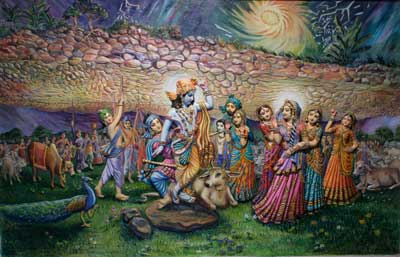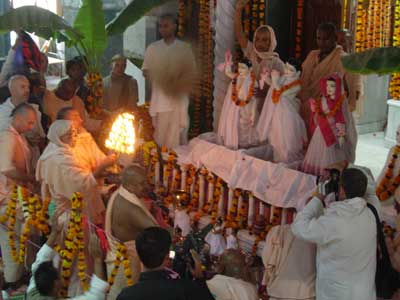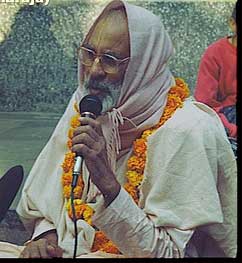Discussions with ISKCON GBC Members
Mathura, India: 1991
On Srila Visvanatha Cakravarti Thakura's Raga-Vartma-Candrika [Part 9] (parts 1,2,3,4,5,6,7, part 9 audio)
Srila Narayana Gosvami Maharaja: Srila Visvanatha Chakravarti Thakura tells us that we should know what is aisvarya and what is madhurya.
What is aisvarya?
Sripad Giriraja Svami: Aisvarya means 'opulence,' or 'majesty.'
Sripad Tamal Krsna Gosvami: It is the majestic feature of the Lord in Dvaraka, Mathura, and Narayana's Vaikuntha; it is worship with awe and reverence.
Srila Narayana Gosvami Maharaja: And what is madhurya?
Sripad Tamal Krsna Gosvami: Sweetness which overpowers His opulence. It is the sweetness of the Lord's pastimes.
Srila Narayana Gosvami Maharaja: This is not a sufficient answer. Sweetness alone is not madhurya. We taste sweet things, but this is not madhurya. We taste something like this in our family relations; and a teenage boy tastes what he calls madhurya, but this is not madhurya. In the background there must be aisvarya, opulence. Without aisvarya there cannot be madhurya.
Do you know what is maha-aisvarya? As aisvarya means 'opulence,' maha-aisvarya means 'great opulence.' Whether or not great opulence is present, if Krsna's pastimes go on as nara-lila, then it is madhurya.
Do you know the meaning of nara-lila?
Sripad Tamal Krsna Gosvami: Worldly.
Burijana dasa: As with humans.
 Srila Narayana Gosvami Maharaja: Whether or not maha-aisvarya is present, if Krsna's pastimes are nara-lila, then it is madhurya. On the other hand, if by the presence of maha-aisvarya Krsna knows that, "I am Isvara, God," and His bhakta also knows that He is God, that is aisvarya-lila.
Srila Narayana Gosvami Maharaja: Whether or not maha-aisvarya is present, if Krsna's pastimes are nara-lila, then it is madhurya. On the other hand, if by the presence of maha-aisvarya Krsna knows that, "I am Isvara, God," and His bhakta also knows that He is God, that is aisvarya-lila.
Someone may propose: "One should understand that sarvajnata, omniscience, indicates an abundance of maha-aisvarya, great opulence, devoid of madhurya, sweetness, while madhurya is simply the mugdhata, or bewilderment, that results from completely setting aside aisvarya and imitating nara-lila, human-like behavior." Only dull-headed people will speak like this.
The conclusion regarding madhurya and related topics is that whether maha-aisvarya is exhibited or not, if the mood of human-like pastimes is not transgressed even slightly, then it is called madhurya. (from Raga-vartma-candrika, Second Illumination)
For example, we have seen that when Krsna and Arjuna were about to fight in the Battle of Kurukshetra, Arjuna saw Krsna's Universal Form and then told Krsna. "I've committed so many offenses at Your lotus feet. I've addressed You as 'friend,' and I have ordered You to drive my chariot. But You are God, my worshipable Lord." This is aisvarya-lila, because Krsna was in the mood that "I am God," and He showed Arjuna His Universal Form. When Arjuna saw that form, he left his mood of friendship with Krsna.
Also, when Krsna went with Baladeva to see Vasudeva and Devaki after killing Kamsa, Vasudeva and Devaki began to worship Krsna with many prayers of glorification. In this instance Krsna was in isvarya-bhava, the conception that He is God. He considered Himself God, and they also knew that He is God.
 On the other hand, the Vrajavasis never considered Him to be God. He went to Govardhana and lifted it with only one finger (the pinky finger of His left hand) for seven days. Indra then came and performed an opulent bathing ceremony for Him, employing several sacred substances, called abhisekha. After this, the elderly gopas assembled and decided, "Let us call Yasoda and Nanda Maharaja. Let us tell them, 'Do not imagine that Krsna is your son. Do not call Him thief, liar, or any other bad name; that will be an offense.'" They advised Nanda Maharaja and Yasoda Maiya to understand that Krsna is perhaps some demigod, or perhaps Narayana Himself, since this is what they had heard from Gargacarya.
On the other hand, the Vrajavasis never considered Him to be God. He went to Govardhana and lifted it with only one finger (the pinky finger of His left hand) for seven days. Indra then came and performed an opulent bathing ceremony for Him, employing several sacred substances, called abhisekha. After this, the elderly gopas assembled and decided, "Let us call Yasoda and Nanda Maharaja. Let us tell them, 'Do not imagine that Krsna is your son. Do not call Him thief, liar, or any other bad name; that will be an offense.'" They advised Nanda Maharaja and Yasoda Maiya to understand that Krsna is perhaps some demigod, or perhaps Narayana Himself, since this is what they had heard from Gargacarya.
Yasoda never thought of Krsna as God. Rather, extremely pleased that her son had lifted Govardhana for seven days, she considered, "Everyone is offering praise to my son," and her breasts became swollen with great pride. If a woman hears anything good about her children, she becomes so pleased. Although Yasoda knew that the act of lifting Govardhana was not that of an ordinary person, she still considered, "Krsna is merely my child; my son." This is madhurya.
As I explained on a previous day, Uddhava came to console the gopis in their mood of separation from Krsna after Krsna went to Mathura. There, he overheard the gopis saying, "We have heard from Paurnamasi and Garga Rsi that Krsna is Isvara, Bhagavan; not only in this birth, but in past births as well, and when He was Ramacandra as well. But we know that even as Ramacandra He did so many wrong things; and He was controlled by Sitadevi."
So, although it had come to their attention through Purnamasi and Gargacarya that Krsna is God, they personally never saw Him as such. This is the nature of their "isvara-bhava." They would tell Him, "Oh, come here. The red lac (decorative paint) on my feet is no longer there. You should repaint it." They would order Him to perform so many services for them, and they would also become angry with Him. If they were actually aware of Krsna's Godhood, how could they have become angry with Him?
Rather, the gopis behaved with Him only as their lover. In their version of "isvara-bhava," they know nothing beyond the idea that He is their beloved. This is madhurya-bhava.
Thus, when Krsna knows that He is Isvara and His bhakta also knows this, that pastime is in aisvarya-bhava. On the other hand, when He and His associates both forget this – and even when some idea comes to them that He may be God, they only behave towards Him like a lover – that is madhurya-bhava.
In Vraja, Krsna is always in Vraja-bhava. He is always overpowered by prema, meaning Yogamaya, His internal desire potency; all actions in Vraja are performed by this prema. It is not against siddhanta to say that Krsna is overpowered by prema, because prema and Krsna are the same Truth: sat-cit-ananda-maya, consisting of eternal existence, unlimited knowledge, and unfathomable joy. This prema is the intrinsic nature of Krsna. Do you know the meaning of svabhava?
Sripad Tamal Krsna Gosvami: Can we say that prema is a sakti (potency) of Krsna, or not?
Srila Narayana Gosvami Maharaja: We may say so. Krsna Himself is known as raso vai sah (the reservoir of the unlimited pleasure of rasa). Rasa is prema (pure love for Krsna), prema is Krsna, and Krsna is prema. And, at the same time, prema is the sakti of Krsna.
Srila Visvanatha Chakravarti Thakura tells us that at the time of rasa-lila, Krsna was sarvajna, all-knowing, because He knew, "All the gopis love Me and want to dance with Me. He knew this, and He therefore expanded into innumerable Krsnas. On the other hand, when He did what the gopis desired, He was mugdha, unaware of His aisvarya. Both qualities are present in Him at the same time. Why? This is due to His acintya-sakti, His potency of inconceivability, which is beyond all mundane logic.
Srila Cakravarti Thakura then says that when, by vaidhi-bhakti, someone worships Narayana, or Rama, or any other plenary expansion of Krsna, that devotee goes to Vaikuntha after attaining perfection.
Sripad Tamal Krsna Gosvami: What about Rukmini-Dvarakadhisa?
Srila Narayana Gosvami Maharaja: I will explain this afterwards, separately. When one performs vaidhi-bhakti and discusses topics regarding Vaikuntha, after achieving perfection he attains Vaikuntha. Regarding those who have no greed but want to serve Radha and Krsna, and they are worshiping Radha and Krsna by the regulations of vaidhi-bhakti – where do they go at the time of perfection (siddhi)?
Burijana dasa: With no greed?
Srila Narayana Gosvami Maharaja: No greed. They are worshiping by vaidhi-bhakti.
Sripad Tamal Krsna Gosvami: To Dvaraka
Srila Narayana Gosvami Maharaja: Why Dvaraka? There is no relation with Dvaraka here.
Sripad Tamal Krsna Gosvami: They are worshiping Radha and Krsna?
Srimad Bhaktivedanta Narayana Maharaja: They want Radha and Krsna.
Sripad Tamal Krsna Gosvami: But no greed?
Srila Narayana Gosvami Maharaja: No greed, and by vaidhi bhakti. In that case, they will attain Goloka. They know nothing about parakiya (Krsna's paramour love with Radhika and the gopis). They only know svakiya (the idea of Sri Sri Radha-Krsna as a married couple). This svakiya is in Goloka.
The planet of Goloka is vast; so many prakostas (separate sections) are situated there.
Sripad Tamal Krsna Gosvami: Levels.
Srila Narayana Gosvami Maharaja: So many. So, if one is worshiping Radha-Krsna by vaidhi-bhakti and has no greed...
Sripad Tamal Krsna Gosvami: Goloka; he goes to Goloka.
Srila Narayana Gosvami Maharaja: Goloka. There in Goloka we find aisvarya-jnana, knowledge of Krsna's Godhood, and svakiya-bhava, the mood of Radha-Krsna as a married couple. There is no conception of parakiya there; only svakiya-bhava – but with the Lord as Radha and Krsna. Every kind of aisvarya (opulence) is present there, almost like that of Narayana, but Krsna is not manifest as Narayana there.
Sripad Tamal Krsna Gosvami: I was reading Garga Samhita, which describes this. As I was reading, I was thinking that this is like Narayana but it is Radha and Krsna. It is not like the Radha-Krsna we always hear about in Vrndavana and Gokula. It's a different mood.
Srila Narayana Gosvami Maharaja: The twenty-four prominent forms of Narayana, as well as all His other forms, reside in lower Vaikuntha. Higher than that is Rama-loka, and higher than that is Krsna-loka. Krsna-loka begins from Goloka, and in Goloka there are so many divisions: Goloka, Dvaraka, Mathura, and then Vraja. In lower Goloka there is only svakiya-bhava with aisvarya-jnana, with no greed at all towards Vraja-bhava.
Sripad Tamal Krsna Gosvami: At the place where Akrura took his bath when he was taking Krsna and Balarama to Mathura, Krsna showed the residents of Vrndavana a vision of Goloka.
Srila Narayana Gosvami Maharaja: Yes, they only saw Goloka, not Vraja, not Vrndavana.
Sripad Tamal Krsna Gosvami: They saw this Goloka?
Srila Narayana Gosvami Maharaja: This Goloka.
Burijana dasa: Krsna showed Vaikuntha to Akrura.
Srila Narayana Gosvami Maharaja: 'Vaikuntha' in this connection refers to this Goloka. He also showed this to the Vrajavasis – not Vraja, only Goloka. Krsna and all His associates including Radhika and Yasoda were there in Goloka in their own forms, but they were not in Vraja-bhava.
Next, suppose someone worships Radha and Krsna in vaidhi-bhakti – not in raga-marga, not under the guidance of a rasika Vaisnava – and at the same time has greed. That devotee will go to Dvaraka. [For example, Brhad-Bhagavatamrta states that Gopa-kumara went to many places before reaching Goloka Vrndavana – even to Dvaraka. He had greed, but because he did not have sufficient rasika association, he could not easily complete his journey to Goloka Vrndavana. -Sripad Madhava Maharaja]
Why will they go there? It is because Radhika manifests as Satybhama there in Dvaraka and Candravali manifests as Rukmini; and because aisvarya-jnana (knowledge of Krsna's Godhood) is present there. When Radha and Candravali are present with Krsna as Satyabhama and Rukmini, Krsna is in His feature as Dvarakadisa and He is served by them in Dvaraka.
Sripad Tamal Krsna Gosvami: What is the difference between someone who worships and goes to Goloka, and someone who worships and goes to Dvaraka?
Srila Narayana Gosvami Maharaja: Those who worship without greed go to Goloka.
Burijana dasa: Only one has greed, but both are worshipping in vaidhi-bhakti?
Sripad Tamal Krsna Gosvami: In Dvaraka there's greed?
Srila Narayana Gosvami Maharaja: Those bhaktas have greed, but they are worshiping in vaidhi-bhakti. In that case Radhika manifests as Satyabhama, Candravali as Rukmini, and their associates as the other queens of Dvaraka. Krsna is in the same form there as He is in Vrndavana, but there He is a young Yadava.
Next, those who have greed for Vraja-bhava and worship Radha-Krsna by raganuga-bhakti under the guidance of a rasika Vrajavasi will achieve Vraja-bhava. Is this clear?
Sripad Tamal Krsna Gosvami: This is very important
Srila Narayana Gosvami Maharaja: This is a very important thing. So I am not wasting my time.
Without knowing these truths, we cannot have a proper idea of Vraja, and we may be deceived. One's svarupa (constitutional spiritual form) will only manifest when one is under the guidance of a rasika Vaisnava.
Sripad Tamal Krsna Gosvami: This gives us the conviction that we must try for the thing you are teaching – raganuga-bhakti.
Srila Narayana Gosvami Maharaja: Yes, raganuga-bhakti.
But you will have to give me daksina (a donation) for this.
Sripad Giriraja Svami: I'll give anything...
Srila Narayana Gosvami Maharaja: I am very greedy. I want daksina.
Sripad Giriraja Svami: Tell me what to give.
Srila Narayana Gosvami Maharaja: I will have to tell you?
Sripad Giriraja Svami: My heart.
Srila Narayana Gosvami Maharaja: Yes.
These are such good topics; we are certainly lucky that we are discussing them. In the practice of bhakti, hundreds of thousands of births may go by and it is not sure that one will have the fortune to discuss such things. It is only the mercy of Guru and Gauranga that we are able to do so.
Another important point: Srila Visvanatha Cakravarti Thakura says that we should not worship Sri Sri Radha and Krsna without pastimes. Do you understand? If we chant "Hare Krsna, Hare Krsna" without remembering Their pastimes, only a very simple thing can be achieved. Srila Rupa Gosvami has therefore said that chanting Krsna's name and remembering His pastimes should be amalgamated – then there will be rasa (the mellow taste of a relationship with Radha and Krsna). For example, if sugar and water remain as they are, without being mixed, there will be no rasa (no nectar-taste of a good drink). Both must mix together; then it will be rasa.
What kind of pastimes should we remember? We should remember Krsna's pastimes with the gopis – if we have a greed for that relationship. It is true that Krsna is always with His hladini-sakti, His pleasure potency. It is also true that Radhika is the personification of His hladini-sakti, also known as His svarupa-sakti (His complete, intrinsic potency). Still, we should not remember Radha and Krsna without Their pastimes. If we remember Them without pastimes, hladini-sakti will not act upon us.
When we go to the mandira (temple), we see Radha and Krsna simply standing on the altar. If this is what we meditate upon when we chant Hare Krsna, then we will have darsana of Satyabhama and Rukmini, or Laxmi. Thus, it is not certain that we will attain Vraja-bhava simply by the worship of Radha and Krsna in the mandira.

We should remember the pastimes of Radha and Krsna as they are served by the manjaris who are under the order of Rupa Manjari and Rati Manjari, and we should meditate on our Gurudeva as one of the manjaris. We should remember the pastimes as described by our Gosvamis and Srimad-Bhagavatam.
When we do arati of Radha and Krsna, we should remember Their pastimes. What pastimes? In the morning, the pastimes of Their morning; and at midday, the pastimes of Their midday; thinking our self as one of Their associates and our Gurudeva as one of them. In that case our bhajana will be raganuga, otherwise it will be simply vaidhi-bhakti.
Burijana dasa: Did the gopis or manjaris ever offer arati? Would they offer arati to Radha and Krsna?
Srila Narayana Gosvami Maharaja: Yes, but you must know what kind of arati they are doing. They have a pradipa.
Sripad Madhava Maharaja: Lamp
Burijana dasa: Ghee lamp.
Srila Narayana Gosvami Maharaja: But in this connection the ghee (clarified butter) is their heart's prema, the pradipa is their heart, and the cotton...
Burijana dasa: Wick.
Srila Narayana Gosvami Maharaja: This is their bhava (their mood of service). What kind of bhava? A special bhava. Every bhakta has a special bhava, and that bhava comes out through the eyes. The gopis worship Krsna by the corners of their eyes, and by Krsna's eyes He accepts their worship and takes it into His heart. The gopis do arcana (worship) in this way; not in the way we do it.
When Krsna comes home from cow-grazing, Yasoda Ma takes a ghee lamp and other paraphernalia, and offers arati to Krsna. The gopis stand at the doorways so that they will not be seen as they perform arcana (worship) with their amour-filled eyes. Due to His glance being absorbed in the arcana of the gopis, Krsna does not see His mother's arati. The gopis' arcana is the best arcana and the best arati. We should see their arati through our arati.
[To be continued...]









